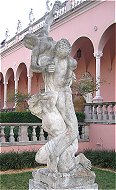Rape of the SabinesMuseum Label: Chiurazzi description: |
Description:
Marble (original by Giovanni da Bologna 1579-83) now in Loggia
dei Lanzi, Florence. According to the legend, men who settled Rome needed wives so they
invited a neighboring tribe to a festival as a ruse. They drove off the men and carried
off the unmarried women. Plutarch ascribes to this the custom of carrying the bride over
the theshold.
The original impressive work was made from one imperfect block of white marble, the
largest block ever transported to Florence. The original is now in the Galleria dell'
Academia. Giambologna wanted to create a composition with the figura serpentina, an upward
snakelike spiral movement to be examined from all sides.
Subject info:
Army general Romulus and his men seized the virgins from the Sabine tribe that started a
war. Through female intercession, the two peoples were later united.
This manneristic celebrated group is called Rape of the Sabine Women by the Flemish artist Jean de Boulogne, better known as Giambologna. The marble pedestal, also by Giambologna, represents bronze bas-reliefs with the same theme. This marble and bronze group is in the Loggia since 1583.
The Loggia dei Lanzi, also called the Loggia della Signoria, is a building on a corner of the Piazza della Signoria in Florence, adjoining the Uffizi Gallery. It consists of wide arches open to the street, three bays wide and one bay deep. The arches rest on clustered pilasters with Corinthian capitals. The wide arches appealed so much to the Florentines, that Michelangelo even proposed that they should be continued all around the Piazza della Signoria.
The Rape of the Sabines marked the climax of Giambologna's career as an official Medici
sculptor. This great marble was unveiled in the Loggia dei Lanzi in January 1583 in place
of Donatello's Judith. The group is indebted to Giambologna's study of Hellenistic
sculpture, particularly in the voids which penetrate the three interlocked figures. On a
technical level it represents the fullfilment of an aspiration from antiquity. Ancient
sources record sculptures made from a single block, a claim which the Renaissance
discovered was not true. Giambologna intended to surpass antiquity by sculpting a large
group from a single block that also involved a complicated lift. The result is the first
sculpture with no principal viewpoints, it forms a spiral that is the culmination of the
"figura serpentina".
Wikipedia:
Giambologna's Rape of the Sabine Women
The sculpture by Giambologna (1579–1583) that was reinterpreted as expressing this
theme depicts three figures (a man lifting a woman into the air while a second man
crouches) and was carved from a single block of marble. Originally intended as nothing
more than a demonstration of the artist's ability to create a complex sculptural group,
its subject matter, the mythical rape of the Sabines, had to be invented after Francesco I
de' Medici, Grand Duke of Tuscany, decreed that it be put on public display in the Loggia
dei Lanzi in Piazza della Signoria. True to mannerist densely-packed, intertwined figural
compositions and ambitious overinclusive efforts, the statue renders a dynamic panoply of
emotions, in poses that offer multiple viewpoints. When contrasted with the serene
single-viewpoint pose of the nearby Michelangelo's David, finished nearly 80 years before,
this statue is infused with the dynamics that lead towards Baroque, but the tight,
uncomfortable, verticality— self-imposed by the author's virtuosic restriction to a
composition that could be carved from a single block of marble— lacks the diagonal
thrusts that Bernini would achieve forty years later with his Rape of Proserpine and
Apollo and Daphne, both at the Galleria Borghese, Rome.
The proposed site for the sculpture, opposite Benvenuto Cellini's statue of Perseus,
prompted suggestions that the group should illustrate a theme related to the former work,
such as the rape of Andromeda by Phineus. The respective rapes of Proserpina and Helen
were also mooted as possibile themes. It was eventually decided that the sculpture was to
be identified as one of the Sabine virgins being abducted by the Romans in an episode from
the early history of Latium.
The work is signed OPVS IOANNIS BOLONII FLANDRI MDLXXXII ("The work of Johannes of
Boulogne of Flanders, 1582"). An early preparatory bronze featuring only two figures
is in the Museo Nazionale di Capodimonte in Naples. Giambologna then revised the scheme,
this time with a third figure, in two wax models now in the Victoria and Albert Museum,
London. The artist's full-scale gesso for the finished sculpture, executed in 1582, is on
display at the Accademia Gallery in Florence.
Bronze reductions of the sculpture, produced in Giambologna's own studio and imitated by
others, were a staple of connoisseurs' collections into the 19th century.
Legend:
The tribe of the Sabines (Latin Sabini - singular Sabinus) was an Italic tribe of ancient
Italy. Their language belonged to the Sabellic subgroup of Italic languages and was akin
to Oscan and Umbrian. More evidence points to the language of the Sabines having been
Greek, as the Sabines originally came from Greece.
Their original territory, straddling the modern regions of Lazio, Umbria, and Abruzzi, was
known as Sabinium in Latin. To this day, it bears the ancient tribe's name and is known as
Sabina in Italian.
Within the modern region of Lazio (or Latium), Sabina constitutes a sub-region, situated
North-East of Rome, around Rieti.
The ancient Sabines were in Latium before Rome was founded. The legend says that Romans
abducted Sabine women to populate the newly built town, resulting in conflict ended only
by the women throwing themselves and their children between the armies of their fathers
and their husbands. The kidnapping (see The Rape of the Sabine Women) is a common motif in
art; the women ending the war is a less frequent but still reappearing motif.
More realistic studies found many relationships between the two peoples, especially
regarding religion and mythology. In fact, many Sabine deities and cults developed in
Rome, and many areas of the town (like the Quirinale) were once Sabine centers.
